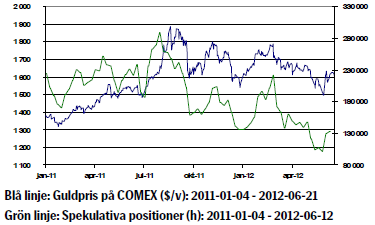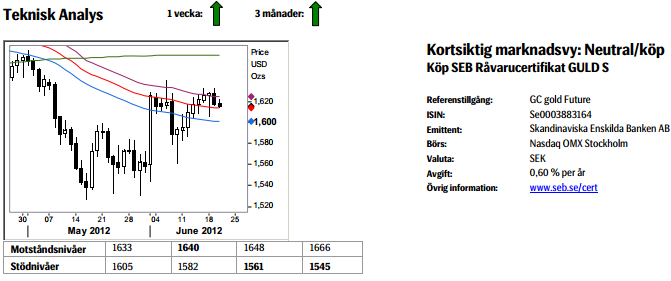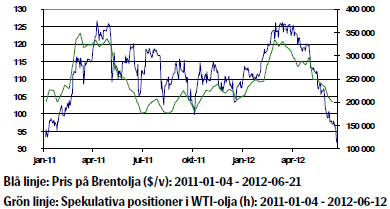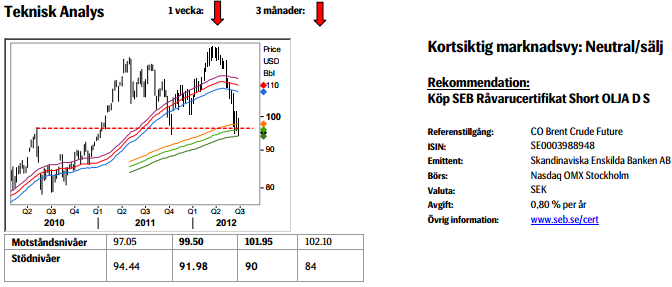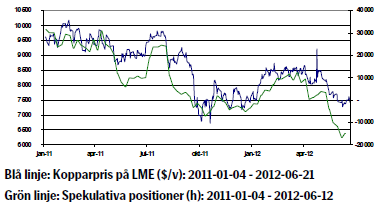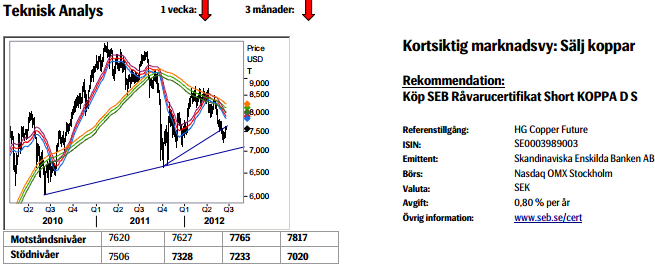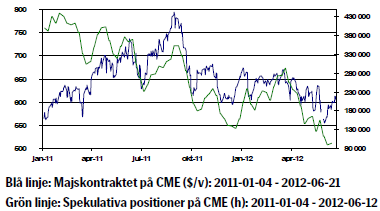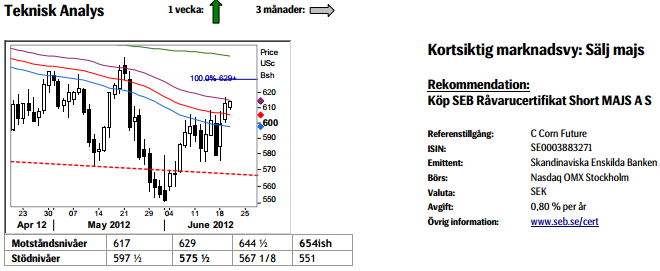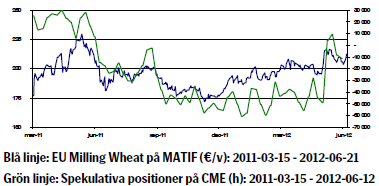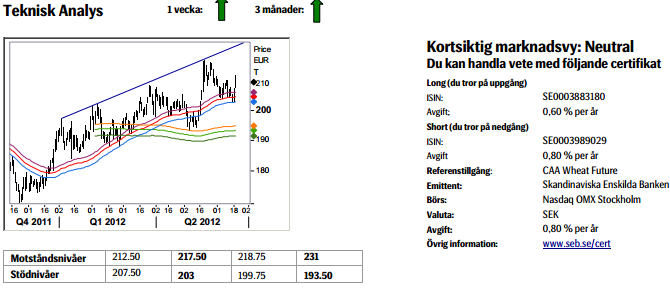Analys
SEB – Råvarukommentarer vecka 25 2012
Sammanfattning: Denna vecka
- Brett råvaruindex: -0,21 %
UBS Bloomberg CMCI TR Index - Energi: -2,95 %
UBS Bloomberg CMCI Energy TR Index - Ädelmetaller: -2,13%
UBS Bloomberg CMCI Precious Metals TR Index - Industrimetaller: -1,71 %
UBS Bloomberg CMCI Industrial Metals TR Index - Jordbruk: +4,46 %
UBS Bloomberg CMCI Agriculture TR Index
Kortsiktig marknadsvy:
Guld: Neutral/köp
Olja: Neutral/sälj
Koppar: Sälj
Majs: Sälj
Vete: Neutral
Guld
Guldpriset har fallit 1,6 procent i veckan och fortsätter att falla idag. Gårdagens Fed-möte gav inte det positiva genomslag man hade hoppats på. Förhoppningarna att Fed skulle intervenera kraftigt var höga men utgången blev försiktiga stimulanser där centralbanken säljer kortare stadspapper och köper längre löptider. Fed behöll även löftet att hålla räntan oförändrad tom slutet av 2014.
Utgången av det grekiska valet förra helgen lugnade marknaden men tendensen är att andningspauserna blir kortare och kortare. Blickarna riktades istället mot Spanien där behovet av en kapitalinjektion sannolikt är mer omfattande än vad tidigare indikerats.
I slutet på veckan kommer nya stresstester för den spanska banksektorn Den spanska 10-årsräntan steg över ohållbara 7.20 procent i veckan. Med sådana finansieringskostnader blir Spaniens situation allt mer ohållbar.
Det viktiga tyska ZEW- index som mäter förväntningarna hos analytiker och institutionella placerare kom in sämre än förväntat. På fredag publiceras ävendet tyska IFO-indexet som mäter humöret i det tyska näringslivet. En viss oro finns att tysk ekonomi visar tecken på försvagning vilket skulle försvåra krisarbetet i EMU-området betydligt. Man har sett i marknaden att hedgefonder positionerar sig för stigande tysk räntor, antingen för att riskerna för den tyska ekonomin ökar eller för att någon from av lösning kommer till stånd.
SEB:s analytiker håller än så länge fast vid synen att guld kommer att nå nya höjder innan året är slut men utfallsrummet är stort och en stop loss i $1500/ozt-trakten att rekommendera.
Teknisk analys: Paus i 55dagars bandet. Efter att nästan till fullo ha reverserat den tidigare sättningen har vi sedan några dagar parkerat i 55dagars bandet, hämtandes andan efter sju dagars uppgång. Efter innevarande konsolidering förväntas vi ta sats för att bryta upp över 1640,50 för att sedan utmana 233dagars bandet. Under ovanstående scenario kan vi inte falla tillbaka under 1,561 utan ett sådant brott skulle flytta oss till det neutrala lägret.
Olja
Brentoljan sjönk i veckan 6,3 procent. Efter gårdagens Fedmöte faller priset kraftigt.
Finansiella investerare positionerar sig avvaktande till ett högre oljepris på kort sikt.
De permanenta medlemmarna i FN:s permanenta säkerhetsråd har under veckans möte i Moskva igen diskuterat Irans kärnvapenprogram, dock utan tydliga framsteg. Mötet inleddes med att man konstaterade att det mest positiva man kunde förvänta sig av mötet var en överenskommelse om att ett nytt möte kommer att äga rum, vilket det kommer att göra i Istanbul den 3:e juli. Iran insisterar på ett lyftande av sanktioner och hävdade sin rätt att anrika uran, villkor som är osannolika att USA och EU kan acceptera. Oron kvarstår att geopolitiska spänningar kommer att intensifieras när nya sanktioner från USA och EU träder i kraft inom två veckor.
OPEC lyckades komma överens om att behålla produktionstaket på 30 mb/d vid sitt möte i Wien förra veckan men Saudiarabien kommer sannolikt inte att göra några snabba neddragningar av sin produktion. Irak har dessutom annonserat att man kommer att höja oljeproduktionen till 3,4 miljoner fat per dag från 3,2 miljoner fat per dag. Det finns för tillfället inga tecken på att den globala överproduktionen av olja kommer att ebba ut.
Onsdagen DOE siffror visade att råoljelager steg 2,9 miljoner fat till 387 miljoner fat, den högsta nivån sedan 1990. Vi ser att amerikanska driving season nu på allvar dragit upp efterfrågan på oljeprodukter.
Vi tror inte att Brentpriset kommer att falla kraftigt från nuvarande nivåer men den globala instabila makroekonomiska situation vi ser för tillfället tynger oljan.
Teknisk analys: På väg igenom falluckan! Hittills har stödet runt 96 förhindrat fortsatt nedgång men med varje studs lägre och lägre ökar hela tiden sannolikheten för att kraftigt brott lägre. Faktum är att om innevarande vecka slutar på nuvarande nivå eller lägre så är brottet ett faktum.
Koppar
Kopparpriset har fallit 1,4 procent under veckan. Effekter av turbulensen i Europa och en ytterligare lokal inbromsning i Kina på kort sikt kommer sannolikt att fortsätta skapa turbulens bland industrimetallerna.
I början av veckan lyfte statistik angående amerikansk husmarknad metallen till 7600 dollar per ton. Husbyggande står för 40 procent av amerikansk efterfrågan. Enligt World Bureau of Metal Statistics (WBMS) var USA världens andra största kopparkonsument 2011. Enligt International Copper Study Group kommer efterfrågan på koppar i USA att öka med 3,9 procent i år.
Kopparn faller kraftigt idag efter Federal Open Market Committees (FOMC) möte igår där tillväxtutsikterna sänktes. Uttalanden om en omfattande amerikansk QE3 (stimulanser) hade sannolikt lyft kopparn men gårdagens mera försiktiga utspel påverkar industrimetallsegmentet negativt idag.
Trots en europeisk skuldkris, vilken påverkar Kina negativt eftersom Europa står för en stor del av Kinas exportefterfrågan, har kinesiska slutkonsumenter funnit nuvarande prisnivåer intressanta för köp. Den för kopparn viktiga fastighetsmarknaden har i Kina blivit rejält avkyld och mycket talar för att man även i Kina kommer att stimulera ekonomin vilket kommer att ge stöd åt bostadssektorn och genom den ge stöd åt kopparpriset. Har man en längre tidshorisont kan det vara intressant att köpa koppar vid prisdippar men vi förväntar oss fortsatt svängig marknad.
Teknisk analys: Återtest av trendlinjen. Den mindre uppgång som noterats senare tid ska med största sannolikhet ses som ett återtest och bekräftelse av brottet av en kortar trendlinje. Vi är därför av åsikten att man ska sälja nuvarande nivåer för en fortsättning ned mot nacklinjen (av den möjliga huvud skuldra toppformationen). Först vid en uppgång över 7817 måste vi ta oss en ordentlig funderare över vår spelplan.
Majs
USDA crop report rapport visar att kvalitén på kommande majs skörd i USA har påverkats negativt av den senaste tidens mycket varma och torra väder, något som fick majspriset att stiga hela tio procent under veckan.
Jordbrukssektorn faller något efter gårdagens Fedmöte men sektorn är ändå den som bäst står emot det breda råvaruprisfallet.
Enligt USDA crop report är har andelen good/excellent minskat till 63 procent jämfört med 66 procent föregående vecka. Det är den lägsta siffran sedan 2008 och är långt under de senaste fem åren som legat på 69 procent.
Framöver kommer nederbörden att vara avgörande för skördens storlek och kvalitet. De nordligaste delarna av USA har haft en god mängd nederbörd medan de centrala och södra delarna har haft torka. Enligt väderprognoser förväntas det torra vädret att fortsätta och med det är det svårt att förvänta sig den rekordskörd som USDA tidigare prognostiserat.
Teknisk analys: Upp från ett slagigt intervall. Lite blåslagna efter en del oförutsedda svängningar har vi nu lämnat ovädersområdet bakom oss. En lite klarare bild pekar på sannolikt fortsatt uppgång och fokus för kommande veckan ligger därför på 1) huruvida vi lyckas passera 55dagars bandet eller ej samt 2) om vi passerar bandet den övre delen av den årslånga svagt sluttande kanalen, just nu vid ~654.
Vete
Spannmålen fortsätter att vara ovilliga att falla tillbaka i någon större utsträckning och vetepriset steg 4,3 procent under veckan. Fortsatt torra förhållanden på stora delar av norra halvklotet (primärt USA och Europe) håller uppe riskpremien. Förhållandena är ännu inte allvarliga men kan snabbt bli om inte regn anländer. Den långsiktiga väderriskpremien har fått stöd från ökande risk för att el Niño slår till igen under andra halvåret.
Torkan i Ryssland fortsätter att driva vetepriset. Det torra och varma vädret förväntas dessutom att fortsätta.
I USA är det torra vädret också ett problem för vårvetet som man precis planterat. Vete är den fjärde största grödan man odlar i USA.
I Europa, där Matif-vetet är referens är vädret emellertid bättre med nederbörd och lägre temperaturer. De för vete viktiga länderna Ukraina och Ryssland har alltför torrt väder vilket kan komma att påverka skörden negativt.
Teknisk analys: Återigen köpare i bandet. Återigen verkar idén om att köparna skulle ånyo återvända i 55dagars bandet ha fungerat enligt plan. Vår medelsiktiga vy pekar fortfarande på att vi inte bara ska passera 2012 års topp (218.75) utan även 2011 års (231).
[box]SEB Veckobrev Veckans råvarukommentar är producerat av SEB Merchant Banking och publiceras i samarbete och med tillstånd på Råvarumarknaden.se[/box]
Disclaimer
The information in this document has been compiled by SEB Merchant Banking, a division within Skandinaviska Enskilda Banken AB (publ) (“SEB”).
Opinions contained in this report represent the bank’s present opinion only and are subject to change without notice. All information contained in this report has been compiled in good faith from sources believed to be reliable. However, no representation or warranty, expressed or implied, is made with respect to the completeness or accuracy of its contents and the information is not to be relied upon as authoritative. Anyone considering taking actions based upon the content of this document is urged to base his or her investment decisions upon such investigations as he or she deems necessary. This document is being provided as information only, and no specific actions are being solicited as a result of it; to the extent permitted by law, no liability whatsoever is accepted for any direct or consequential loss arising from use of this document or its contents.
About SEB
SEB is a public company incorporated in Stockholm, Sweden, with limited liability. It is a participant at major Nordic and other European Regulated Markets and Multilateral Trading Facilities (as well as some non-European equivalent markets) for trading in financial instruments, such as markets operated by NASDAQ OMX, NYSE Euronext, London Stock Exchange, Deutsche Börse, Swiss Exchanges, Turquoise and Chi-X. SEB is authorized and regulated by Finansinspektionen in Sweden; it is authorized and subject to limited regulation by the Financial Services Authority for the conduct of designated investment business in the UK, and is subject to the provisions of relevant regulators in all other jurisdictions where SEB conducts operations. SEB Merchant Banking. All rights reserved.
Analys
More weakness and lower price levels ahead, but the world won’t drown in oil in 2026

Some rebound but not much. Brent crude rebounded 1.5% yesterday to $65.47/b. This morning it is inching 0.2% up to $65.6/b. The lowest close last week was on Thursday at $64.11/b.

The curve structure is almost as week as it was before the weekend. The rebound we now have gotten post the message from OPEC+ over the weekend is to a large degree a rebound along the curve rather than much strengthening at the front-end of the curve. That part of the curve structure is almost as weak as it was last Thursday.
We are still on a weakening path. The message from OPEC+ over the weekend was we are still on a weakening path with rising supply from the group. It is just not as rapidly weakening as was feared ahead of the weekend when a quota hike of 500 kb/d/mth for November was discussed.
The Brent curve is on its way to full contango with Brent dipping into the $50ies/b. Thus the ongoing weakening we have had in the crude curve since the start of the year, and especially since early June, will continue until the Brent crude oil forward curve is in full contango along with visibly rising US and OECD oil inventories. The front-month Brent contract will then flip down towards the $60/b-line and below into the $50ies/b.
At what point will OPEC+ turn to cuts? The big question then becomes: When will OPEC+ turn around to make some cuts? At what (price) point will they choose to stabilize the market? Because for sure they will. Higher oil inventories, some more shedding of drilling rigs in US shale and Brent into the 50ies somewhere is probably where the group will step in.
There is nothing we have seen from the group so far which indicates that they will close their eyes, let the world drown in oil and the oil price crash to $40/b or below.
The message from OPEC+ is also about balance and stability. The world won’t drown in oil in 2026. The message from the group as far as we manage to interpret it is twofold: 1) Taking back market share which requires a lower price for non-OPEC+ to back off a bit, and 2) Oil market stability and balance. It is not just about 1. Thus fretting about how we are all going to drown in oil in 2026 is totally off the mark by just focusing on point 1.
When to buy cal 2026? Before Christmas when Brent hits $55/b and before OPEC+ holds its last meeting of the year which is likely to be in early December.
Brent crude oil prices have rebounded a bit along the forward curve. Not much strengthening in the structure of the curve. The front-end backwardation is not much stronger today than on its weakest level so far this year which was on Thursday last week.

The front-end backwardation fell to its weakest level so far this year on Thursday last week. A slight pickup yesterday and today, but still very close to the weakest year to date. More oil from OPEC+ in the coming months and softer demand and rising inventories. We are heading for yet softer levels.

Analys
A sharp weakening at the core of the oil market: The Dubai curve

Down to the lowest since early May. Brent crude has fallen sharply the latest four days. It closed at USD 64.11/b yesterday which is the lowest since early May. It is staging a 1.3% rebound this morning along with gains in both equities and industrial metals with an added touch of support from a softer USD on top.

What stands out the most to us this week is the collapse in the Dubai one to three months time-spread.
Dubai is medium sour crude. OPEC+ is in general medium sour crude production. Asian refineries are predominantly designed to process medium sour crude. So Dubai is the real measure of the balance between OPEC+ holding back or not versus Asian oil demand for consumption and stock building.
A sharp weakening of the front-end of the Dubai curve. The front-end of the Dubai crude curve has been holding out very solidly throughout this summer while the front-end of the Brent and WTI curves have been steadily softening. But the strength in the Dubai curve in our view was carrying the crude oil market in general. A source of strength in the crude oil market. The core of the strength.
The now finally sharp decline of the front-end of the Dubai crude curve is thus a strong shift. Weakness in the Dubai crude marker is weakness in the core of the oil market. The core which has helped to hold the oil market elevated.
Facts supports the weakening. Add in facts of Iraq lifting production from Kurdistan through Turkey. Saudi Arabia lifting production to 10 mb/d in September (normal production level) and lifting exports as well as domestic demand for oil for power for air con is fading along with summer heat. Add also in counter seasonal rise in US crude and product stocks last week. US oil stocks usually decline by 1.3 mb/week this time of year. Last week they instead rose 6.4 mb/week (+7.2 mb if including SPR). Total US commercial oil stocks are now only 2.1 mb below the 2015-19 seasonal average. US oil stocks normally decline from now to Christmas. If they instead continue to rise, then it will be strongly counter seasonal rise and will create a very strong bearish pressure on oil prices.
Will OPEC+ lift its voluntary quotas by zero, 137 kb/d, 500 kb/d or 1.5 mb/d? On Sunday of course OPEC+ will decide on how much to unwind of the remaining 1.5 mb/d of voluntary quotas for November. Will it be 137 kb/d yet again as for October? Will it be 500 kb/d as was talked about earlier this week? Or will it be a full unwind in one go of 1.5 mb/d? We think most likely now it will be at least 500 kb/d and possibly a full unwind. We discussed this in a not earlier this week: ”500 kb/d of voluntary quotas in October. But a full unwind of 1.5 mb/d”
The strength in the front-end of the Dubai curve held out through summer while Brent and WTI curve structures weakened steadily. That core strength helped to keep flat crude oil prices elevated close to the 70-line. Now also the Dubai curve has given in.

Brent crude oil forward curves

Total US commercial stocks now close to normal. Counter seasonal rise last week. Rest of year?

Total US crude and product stocks on a steady trend higher.

Analys
OPEC+ will likely unwind 500 kb/d of voluntary quotas in October. But a full unwind of 1.5 mb/d in one go could be in the cards

Down to mid-60ies as Iraq lifts production while Saudi may be tired of voluntary cut frugality. The Brent December contract dropped 1.6% yesterday to USD 66.03/b. This morning it is down another 0.3% to USD 65.8/b. The drop in the price came on the back of the combined news that Iraq has resumed 190 kb/d of production in Kurdistan with exports through Turkey while OPEC+ delegates send signals that the group will unwind the remaining 1.65 mb/d (less the 137 kb/d in October) of voluntary cuts at a pace of 500 kb/d per month pace.

Signals of accelerated unwind and Iraqi increase may be connected. Russia, Kazakhstan and Iraq were main offenders versus the voluntary quotas they had agreed to follow. Russia had a production ’debt’ (cumulative overproduction versus quota) of close to 90 mb in March this year while Kazakhstan had a ’debt’ of about 60 mb and the same for Iraq. This apparently made Saudi Arabia angry this spring. Why should Saudi Arabia hold back if the other voluntary cutters were just freeriding? Thus the sudden rapid unwinding of voluntary cuts. That is at least one angle of explanations for the accelerated unwinding.
If the offenders with production debts then refrained from lifting production as the voluntary cuts were rapidly unwinded, then they could ’pay back’ their ’debts’ as they would under-produce versus the new and steadily higher quotas.
Forget about Kazakhstan. Its production was just too far above the quotas with no hope that the country would hold back production due to cross-ownership of oil assets by international oil companies. But Russia and Iraq should be able to do it.
Iraqi cumulative overproduction versus quotas could reach 85-90 mb in October. Iraq has however steadily continued to overproduce by 3-5 mb per month. In July its new and gradually higher quota came close to equal with a cumulative overproduction of only 0.6 mb that month. In August again however its production had an overshoot of 100 kb/d or 3.1 mb for the month. Its cumulative production debt had then risen to close to 80 mb. We don’t know for September yet. But looking at October we now know that its production will likely average close to 4.5 mb/d due to the revival of 190 kb/d of production in Kurdistan. Its quota however will only be 4.24 mb/d. Its overproduction in October will thus likely be around 250 kb/d above its quota with its production debt rising another 7-8 mb to a total of close to 90 mb.
Again, why should Saudi Arabia be frugal while Iraq is freeriding. Better to get rid of the voluntary quotas as quickly as possible and then start all over with clean sheets.
Unwinding the remaining 1.513 mb/d in one go in October? If OPEC+ unwinds the remaining 1.513 mb/d of voluntary cuts in one big go in October, then Iraq’s quota will be around 4.4 mb/d for October versus its likely production of close to 4.5 mb/d for the coming month..
OPEC+ should thus unwind the remaining 1.513 mb/d (1.65 – 0.137 mb/d) in one go for October in order for the quota of Iraq to be able to keep track with Iraq’s actual production increase.
October 5 will show how it plays out. But a quota unwind of at least 500 kb/d for Oct seems likely. An overall increase of at least 500 kb/d in the voluntary quota for October looks likely. But it could be the whole 1.513 mb/d in one go. If the increase in the quota is ’only’ 500 kb/d then Iraqi cumulative production will still rise by 5.7 mb to a total of 85 mb in October.
Iraqi production debt versus quotas will likely rise by 5.7 mb in October if OPEC+ only lifts the overall quota by 500 kb/d in October. Here assuming historical production debt did not rise in September. That Iraq lifts its production by 190 kb/d in October to 4.47 mb/d (August level + 190 kb/d) and that OPEC+ unwinds 500 kb/d of the remining quotas in October when they decide on this on 5 October.

-

 Nyheter4 veckor sedan
Nyheter4 veckor sedanMahvie Minerals i en guldtrend
-

 Analys4 veckor sedan
Analys4 veckor sedanVolatile but going nowhere. Brent crude circles USD 66 as market weighs surplus vs risk
-

 Nyheter4 veckor sedan
Nyheter4 veckor sedanAktier i guldbolag laggar priset på guld
-

 Nyheter3 veckor sedan
Nyheter3 veckor sedanKinas elproduktion slog nytt rekord i augusti, vilket även kolkraft gjorde
-

 Nyheter3 veckor sedan
Nyheter3 veckor sedanTyskland har så höga elpriser att företag inte har råd att använda elektricitet
-

 Nyheter4 veckor sedan
Nyheter4 veckor sedanGuld når sin högsta nivå någonsin, nu även justerat för inflation
-

 Nyheter4 veckor sedan
Nyheter4 veckor sedanDet stigande guldpriset en utmaning för smyckesköpare
-

 Analys4 veckor sedan
Analys4 veckor sedanWaiting for the surplus while we worry about Israel and Qatar



